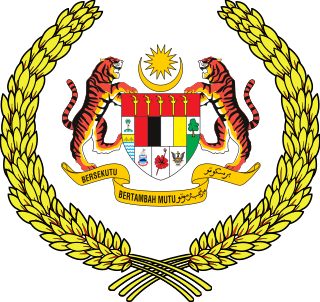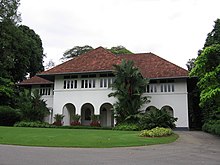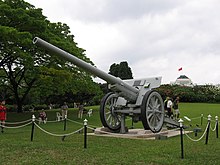Yang di-Pertuan Negara is a title for the head of state in certain Malay-speaking countries, and has been used as an official title at various times in Brunei and Singapore.

The prime minister of Singapore is the head of government of Singapore. The president appoints the prime minister, a Member of Parliament (MP) who in their opinion, is most likely to command the confidence of the majority of MPs. The incumbent prime minister is Lawrence Wong, who took office on 15 May 2024.

The president of the Republic of Singapore is the head of state of Singapore. The president represents the country in official diplomatic functions and possesses certain executive powers over the Government of Singapore, including the control of the national reserves and the ability to revoke and appoint public service appointments.

The Yang di-Pertuan Agong, also known as the Supreme Head of the Federation, the Paramount Ruler, or simply the Agong and also unofficially as the King of Malaysia, is the constitutional monarch and head of state of Malaysia. The office was established in 1957, when the Federation of Malaya gained independence from the United Kingdom. The Yang di-Pertuan Agong is elected by the Conference of Rulers, comprising the nine rulers of the Malay states, with the office de facto rotated between them, making Malaysia one of the world's few elective monarchies.
In Malaysia, the Yang di-Pertua Negeri is a constitutional title given to the head of state in states without a ruler, namely: Penang, Malacca, Sabah and Sarawak. This is in contrast to a Ruler which is a constitutional title given to states with hereditary monarchies, namely: the Sultans of Johor, Kedah, Kelantan, Pahang, Perak, Selangor and Terengganu; the Raja of Perlis: and the Yang di-Pertuan Besar of Negeri Sembilan.

The Parliament of Malaysia is the national legislature of Malaysia, based on the Westminster system. The bicameral parliament consists of the Dewan Rakyat and the Dewan Negara. The Yang di-Pertuan Agong (King), as the head of state, is the third component of Parliament.
An official residence is a residence designated by an authority and assigned to an official, and may not always be the same place where the office holder conducts their official functions or lives.

The Government of Singapore is defined by the Constitution of the Republic of Singapore to consist of the President and the Executive. Executive authority of Singapore is vested in the President but exercised on the advice of the Cabinet led by the Prime Minister. The President, acting as the Head of State, may only act in their discretion in appointing the Prime Minister, acting as the Head of Government; as well as withholding consent for the dissolution of Parliament; along with performing key checks on the Government in addition to the ceremonial duties of the Head of State inherited from the Westminster system. The Cabinet, consisting of the Prime Minister and ministers appointed by the President on the Prime Minister's advice, is responsible for heading the Executive through ministries and other statutory boards. At the end of the term or at any time during the term, once the President has consented to a request made by the Prime Minister to dissolve Parliament, Parliamentary General Elections are held to elect members of Parliament for a new term. The President, in their discretion, then appoints a Prime Minister who is a member of Parliament representing any political party or coalition of political parties who in their judgement is likely to command the confidence of the majority of the members of Parliament. The Prime Minister then forms the Government and, along with the Cabinet, sets the general direction and control of the Government for the next term.
The Darjah Utama Temasek is Singapore's second most prestigious national honour and was instituted in 1962. It is an Order conferred by the President of Singapore only to citizens of Singapore. It may be awarded to non-citizens only under special circumstances.

The Royal Museum along Jalan Istana was the former National Palace and former residence of the Yang di-Pertuan Agong of Malaysia. It stands on a 13-acre (50,000 m2) site, located on a commanding position on the slope of a hill of Bukit Petaling overlooking the Klang River, along Jalan Syed Putra.

Istana Negara is one of the six presidential palaces of Indonesia. It is located on Veteran Street in Central Jakarta, with Merdeka Palace located south. It is part of the presidential palace compound which has a total area of 68,000 m², along with three other buildings: Bina Graha which was formerly used as the President's Office, Wisma Negara on the western side which is used as the state guest house, and the office for the Ministry of State Secretariat of Indonesia. Istana Negara faces north towards the aforementioned street, while the Merdeka Palace faces Merdeka Square and the National Monument (Monas).

The Merdeka Palace, is one of six presidential palaces in Indonesia. It is located on the north side of the Merdeka Square in Central Jakarta, Indonesia, and is used as the official residence of the president of the Republic of Indonesia.
The following lists events that happened during 1963 in Singapore.

Yusof bin Ishak was a Singaporean journalist and senior civil servant who served as the first president of Singapore between 1965 and 1970.

Sri Temasek is a two-storey detached house built in 1869 which is sited within the grounds of the Istana in Singapore. During the island's colonial era, it served as the residence of the Chief Secretary. Since Singapore gained self-governance from the United Kingdom in 1959, the house has been the official residence of the Prime Minister of Singapore, though none of the prime ministers have ever lived there. Together with the Istana, it was gazetted a national monument on 14 February 1992.
The following lists events that happened during 1959 in Singapore.

The Former City Hall building in Singapore is a national monument gazetted on 14 February 1992. It can be found in front of the historical Padang and adjacent to the Former Supreme Court of Singapore, it was designed and built by the architects of the Singapore Municipal Commission, A. Gordans and F. D. Meadows from 1926 to 1929. A flight of stairs takes visitors from the Corinthian colonnade to the main building. The building was constructed to replace several houses designed by architect G.D. Coleman. It was first known as Municipal Building until 1951 when Singapore was granted city status by King George VI.

The Istana Negara is the official residence of the Yang di-Pertuan Agong, the monarch of Malaysia. It is located along Jalan Tuanku Abdul Halim near Taman Duta, northwestern Kuala Lumpur. The palace opened in 2011 and replaced the old Istana Negara which was located at a different compound in central Kuala Lumpur.
The installation of the Yang di-Pertuan Agong is a ceremony that formally marks the beginning of the reign of the Yang di-Pertuan Agong as the Malaysian head of state.
Events in the year 2020 in Malaysia.
















